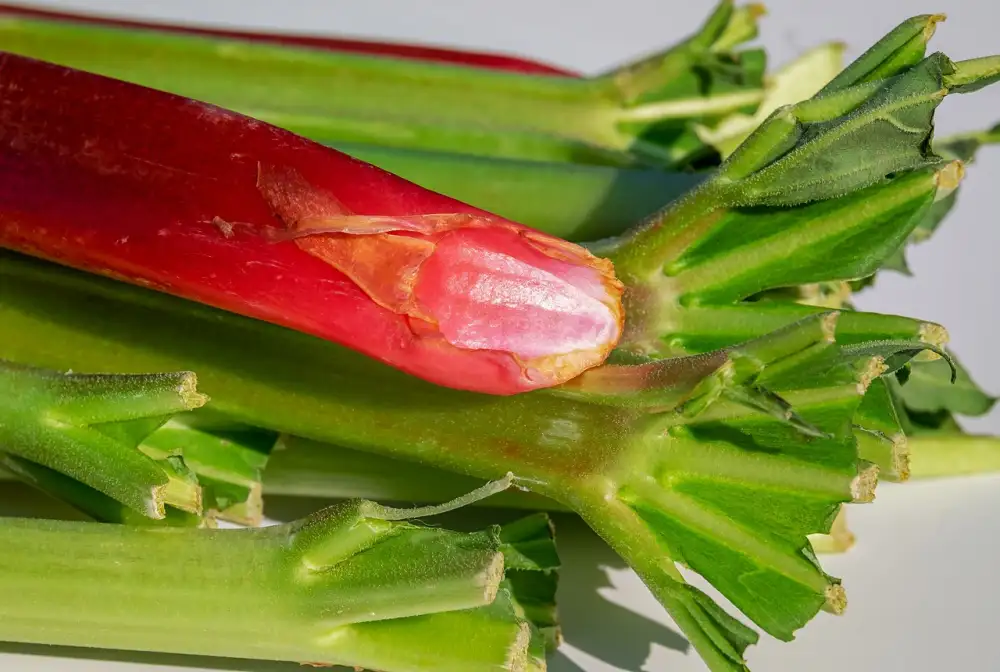Rhubarb Harvesting Guide: Discover the Perfect Time to Harvest Your Homegrown Rhubarb

- Importance of knowing when to harvest rhubarb
- Brief overview of the article's content
- Understanding Rhubarb Growth
- Explanation of rhubarb plant's life cycle
- Description of key growth stages
- Signs of Readiness
- Visual cues to look for when determining if rhubarb is ready to be harvested
- Color, size, and texture indicators
- Timing the Harvest
- Factors to consider when deciding the best time to harvest rhubarb
- Weather conditions, plant age, and growth rate
- Harvesting Techniques
- Step-by-step instructions on how to properly harvest rhubarb
- Tools needed and recommended methods
- Storing and Using Harvested Rhubarb
- Tips for storing freshly harvested rhubarb
- Suggestions for various culinary uses
- Recap of key points discussed in the article
- Encouragement to enjoy the freshness of homegrown rhubarb
Knowing when to harvest rhubarb is essential for enjoying its fresh and tangy flavor. In this article, we will guide you through the process of harvesting your homegrown rhubarb at the perfect time. We will explore the growth stages of rhubarb, signs of readiness, factors to consider for timing the harvest, techniques for harvesting, and tips for storing and using your harvested rhubarb. Get ready to celebrate the freshness of homegrown rhubarb in every food creation!
Importance of knowing when to harvest rhubarb
Knowing when to harvest rhubarb is crucial in order to enjoy the best flavor and texture. Harvesting too early or too late can result in tough, stringy stalks that are less enjoyable to eat. By understanding the signs of readiness and timing the harvest correctly, you can ensure that your homegrown rhubarb is at its peak freshness and ready to be used in a variety of delicious dishes.
Brief overview of the article's content
In this article, we will explore the importance of knowing when to harvest rhubarb and provide a comprehensive guide to help you determine the perfect time to harvest your homegrown rhubarb. We will delve into the growth stages of rhubarb plants and discuss the visual cues that indicate readiness for harvesting. Additionally, we will cover factors to consider when timing the harvest, as well as step-by-step instructions on how to properly harvest rhubarb. Furthermore, we will provide tips on storing freshly harvested rhubarb and offer suggestions for various culinary uses. Join us as we celebrate the freshness of homegrown rhubarb!
Understanding Rhubarb Growth
Rhubarb is a perennial plant that goes through different growth stages throughout its life cycle. It starts with the emergence of new shoots in early spring, followed by the development of large, vibrant green leaves. As the plant continues to grow, it produces thick stalks that are ready for harvest.
Key growth stages include the initial leaf stage, when the plant focuses on establishing a strong root system. This is followed by the leaf expansion stage, where the leaves grow larger and provide energy for future stalk production. Finally, the stalk development stage occurs when the rhubarb plant reaches maturity and produces thick, juicy stalks.
Understanding these growth stages is crucial in determining when to harvest rhubarb. By observing and monitoring your plants closely, you can ensure that you harvest at the perfect time to enjoy the best flavor and texture.
Explanation of rhubarb plant's life cycle
Rhubarb plants have a unique life cycle that is important to understand in order to properly harvest them. Rhubarb is a perennial plant, meaning it lives for multiple years. In the first year of planting, rhubarb focuses on establishing its root system and building up energy reserves. During this time, it's best to avoid harvesting any stalks.
In the second year, rhubarb enters its growth phase. This is when the plant produces large, leafy stalks that can be harvested. It's important to note that only the stalks should be harvested, as the leaves are toxic and should never be consumed.
After several years of growth and harvesting, rhubarb may start to decline in productivity. This is a natural part of the plant's life cycle, and it may be necessary to divide and replant the rhubarb crowns to maintain healthy growth.
Understanding the different stages of rhubarb's life cycle will help you determine when it's appropriate to start harvesting and ensure you have a bountiful supply of fresh rhubarb for years to come.
Description of key growth stages
Rhubarb goes through several key growth stages during its life cycle. In the early spring, the plant emerges from the ground as small, red shoots. As it grows, the leaves unfurl and become larger, while the stalks thicken and develop their characteristic bright red color. At this stage, the rhubarb is still young and should not be harvested. Over time, the stalks continue to grow taller and thicker until they reach their mature size. It is important to wait until the stalks have reached their full size before harvesting to ensure optimal flavor and texture.
Signs of Readiness
When determining if rhubarb is ready to be harvested, there are several visual cues to look for. Firstly, the color of the stalks should be vibrant and deep red or pink, depending on the variety. Avoid harvesting rhubarb with green or pale stalks as they may not be fully matured. Secondly, the size of the stalks should be thick and sturdy, typically around 1 inch in diameter. Lastly, the texture of the stalks should feel firm and crisp when gently squeezed. If the stalks easily bend or feel mushy, they are likely overripe and should not be harvested. Keep an eye out for these signs to ensure you harvest your rhubarb at its peak freshness.
Visual cues to look for when determining if rhubarb is ready to be harvested
When determining if rhubarb is ready to be harvested, there are several visual cues to look for. Firstly, the stalks should be thick and firm, with a vibrant color. The ideal size for harvesting is around 10-15 inches long. Additionally, the leaves should be fully open and healthy-looking. Finally, the texture of the stalks should be crisp and not limp or rubbery. By paying attention to these visual indicators, you can ensure that your rhubarb is at its prime for harvesting.
Color, size, and texture indicators
When determining if rhubarb is ready to be harvested, there are several visual cues to look for. The color of the stalks should be vibrant and have a deep red or pink hue. The size of the stalks should be thick and sturdy, typically around 1 to 2 inches in diameter. In terms of texture, the stalks should feel firm and crisp when gently squeezed. Avoid harvesting rhubarb with thin or green stalks as they may not have reached their full maturity and flavor.
Timing the Harvest
When it comes to harvesting rhubarb, timing is crucial. Several factors should be considered to determine the best time to harvest your homegrown rhubarb. Firstly, keep an eye on the weather conditions. Wait until the soil has warmed up and the danger of frost has passed. This usually occurs in early spring.
Another factor to consider is the age of your plant. It's generally recommended to wait until the second or third year before harvesting rhubarb. This allows the plant to establish a strong root system and ensures a more abundant harvest in future years.
Lastly, pay attention to the growth rate of your rhubarb. The stalks should be thick and firm before harvesting. If they are still thin and floppy, it's a sign that they need more time to mature.
By taking these factors into account, you can ensure that you harvest your rhubarb at its peak flavor and texture, ready for all your culinary creations.
Factors to consider when deciding the best time to harvest rhubarb
When deciding the best time to harvest rhubarb, there are several factors to consider. Firstly, weather conditions play a crucial role. Rhubarb should be harvested when the soil is dry and not waterlogged, as wet conditions can lead to rotting. Additionally, plant age is important. It is recommended to wait until the second year of growth before harvesting rhubarb, as this allows the plant to establish strong roots and ensures a more abundant harvest in subsequent years. Lastly, the growth rate of the plant should be taken into account. Rhubarb stalks should be thick and firm before harvesting, indicating that they have reached their full potential for flavor and texture. By considering these factors, you can ensure that you harvest your rhubarb at its peak freshness and taste.
Weather conditions, plant age, and growth rate
When deciding the best time to harvest your rhubarb, it's important to consider several factors. One of the key factors is the weather conditions. Rhubarb thrives in cooler temperatures, so harvesting during mild spring or fall weather is ideal. Extreme heat can cause the stalks to become tough and stringy.
Another factor to consider is the age of the plant. Rhubarb plants typically reach maturity after their second year of growth. Harvesting too early can weaken the plant, while waiting too long can result in tough and woody stalks.
Lastly, pay attention to the growth rate of your rhubarb. The size and thickness of the stalks are good indicators of readiness for harvest. Stalks should be thick and firm, with vibrant coloration. If they easily snap off when pulled, it's a sign that they are ready to be harvested.
Harvesting Techniques
To ensure the best flavor and texture, it's important to harvest rhubarb correctly. Here are some step-by-step instructions to guide you:
1. Choose the right time: Wait until the stalks are thick and firm, usually around 10-12 inches long. Avoid harvesting during the plant's first year to allow it to establish properly.
2. Prepare your tools: Use a sharp knife or garden shears to cut the stalks cleanly at the base. Avoid pulling or twisting, as this can damage the plant.
3. Cut with care: Hold the stalk near its base and make a clean cut just above ground level. Remove any leaves attached to the stalks, as they are toxic and should never be consumed.
4. Leave some stalks behind: Only harvest one-third of the plant's stalks at a time to allow for continuous growth throughout the season.
5. Dispose of any damaged stalks: If you come across any discolored or slimy stalks, discard them immediately to prevent disease spread.
By following these techniques, you'll ensure a bountiful harvest of fresh and delicious rhubarb from your own garden!
Step-by-step instructions on how to properly harvest rhubarb
To properly harvest rhubarb, follow these step-by-step instructions:
1. Wait until the plant is at least two years old before harvesting.
2. Choose a dry day to harvest when the soil is not too wet.
3. Firmly grasp the stalk near the base and gently pull it away from the plant.
4. Use a sharp knife or garden shears to cut the stalk at ground level if it does not easily pull away.
5. Avoid damaging any new shoots or leaves while harvesting.
6. Harvest only about one-third of the stalks at a time to allow the plant to continue growing.
7. Remove any leaves from the harvested stalks as they are toxic and should not be consumed.
8. Enjoy your freshly harvested rhubarb in various culinary creations!
Tools needed and recommended methods
When it comes to harvesting rhubarb, you don't need any fancy tools. All you really need is a sharp knife or garden shears. Make sure your tool is clean and sanitized before using it to prevent any potential contamination.
To harvest rhubarb, start by selecting the stalks that are ready for picking. Look for stalks that are thick and firm, with vibrant colors such as deep red or bright pink. Avoid harvesting thin or floppy stalks as they may not be fully matured.
To remove the stalks, simply cut them at the base where they meet the crown of the plant. Be careful not to damage any surrounding leaves or stems. It's important to leave at least two-thirds of the plant intact so it can continue to grow and produce more rhubarb throughout the season.
Once you've harvested your rhubarb, it's best to use it as soon as possible for maximum freshness and flavor. However, if you can't use it right away, store it in the refrigerator in a plastic bag or wrapped in damp paper towels to keep it moist.
Remember, harvesting rhubarb is an exciting process that allows you to enjoy the fruits of your labor. So grab your tools and get ready to savor the deliciousness of homegrown rhubarb!
Storing and Using Harvested Rhubarb
6. Storing and Using Harvested Rhubarb
After harvesting your rhubarb, it's important to store it properly to maintain its freshness. Start by removing any leaves attached to the stalks, as they can draw moisture away from the rhubarb. Then, wash the stalks thoroughly and pat them dry.
To store rhubarb in the refrigerator, wrap the stalks in a damp paper towel and place them in a plastic bag. This will help retain moisture and prevent wilting. Rhubarb can stay fresh in the refrigerator for up to two weeks.
When it comes to using your freshly harvested rhubarb, the possibilities are endless. You can use it in pies, crumbles, jams, sauces, or even add it to savory dishes like chutneys or pickles. Its tart flavor pairs well with sweet fruits like strawberries or apples.
Remember to remove any tough strings that may be present on older stalks before cooking. Simply peel them away with a knife or vegetable peeler.
So go ahead and enjoy the vibrant flavors of your homegrown rhubarb by experimenting with different recipes and preserving methods. The reward of savoring your own harvest is truly worth it!
Tips for storing freshly harvested rhubarb
1. Trim the leaves: Cut off the leaves from the rhubarb stalks as soon as you harvest them. The leaves contain high levels of oxalic acid, which can be toxic if consumed in large quantities.
2. Rinse and dry: Give the stalks a gentle rinse to remove any dirt or debris. Pat them dry with a clean towel before storing.
3. Refrigerate in a plastic bag: Place the rhubarb stalks in a plastic bag and seal it tightly. Store them in the refrigerator's crisper drawer to maintain freshness.
4. Use within a week: Freshly harvested rhubarb is best used within a week to enjoy its optimal flavor and texture. After that, it may start to lose its crispness.
5. Freeze for long-term storage: If you have an abundance of rhubarb, consider freezing it for later use. Simply chop the stalks into desired sizes, blanch them briefly in boiling water, then transfer to freezer-safe bags or containers.
By following these storage tips, you can preserve the freshness of your homegrown rhubarb and enjoy its tangy goodness in various culinary creations throughout the year.
Suggestions for various culinary uses
Once you have harvested your homegrown rhubarb, the possibilities for culinary creations are endless. One classic use for rhubarb is in pies and crumbles, where its tartness pairs perfectly with sweet flavors. You can also make delicious jams and preserves to enjoy throughout the year. Rhubarb can be stewed or roasted to create a compote that can be used as a topping for pancakes, yogurt, or ice cream. For a refreshing twist, try making rhubarb lemonade or adding it to cocktails. Additionally, rhubarb can be used in savory dishes such as chutneys or sauces to accompany meats like pork or chicken. Let your creativity flow and experiment with different recipes to fully appreciate the unique flavor of freshly harvested rhubarb.
In conclusion, knowing the perfect time to harvest your homegrown rhubarb is crucial for enjoying its freshness and flavor. By understanding the growth stages and signs of readiness, you can ensure that you pick your rhubarb at its peak. Consider factors like weather conditions and plant age when timing the harvest. Use proper techniques, such as cutting the stalks at the base, to preserve the plant's health. Once harvested, store your rhubarb properly and explore various culinary uses to make the most of this versatile ingredient. Enjoy the goodness of freshly harvested rhubarb in your favorite recipes!
Recap of key points discussed in the article
In conclusion, knowing when to harvest your homegrown rhubarb is crucial for enjoying its freshness. We have discussed the importance of understanding rhubarb growth and the key stages it goes through. Visual cues such as color, size, and texture can help determine if rhubarb is ready to be harvested. Factors like weather conditions, plant age, and growth rate should be considered when timing the harvest. Proper harvesting techniques involve using the right tools and following recommended methods. Lastly, storing freshly harvested rhubarb correctly will ensure its longevity. So go ahead and celebrate the freshness of your homegrown rhubarb in various culinary creations!
Encouragement to enjoy the freshness of homegrown rhubarb
In conclusion, harvesting your homegrown rhubarb at the right time ensures that you can enjoy its freshness and delicious flavor. By understanding the growth stages and signs of readiness, you can confidently harvest your rhubarb when it is at its peak. Remember to consider factors such as weather conditions and plant age when timing the harvest. Once harvested, store your rhubarb properly to maintain its freshness. Whether you use it in pies, jams, or savory dishes, the versatility of rhubarb will surely delight your taste buds. So go ahead, savor the goodness of homegrown rhubarb and celebrate the freshness in every food creation!
Published: 11. 12. 2023
Category: Home



